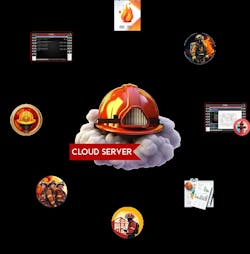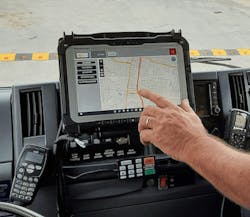Incident Command: Implementing Tech for Firefighter Safety
No element of response to fires and other incidents is more important to fire department leadership, incident commanders (ICs) and municipalities than the safety of their firefighters. Evidence of this is found in those groups’ dedication to investigation into and acquisition of technology that ICs use to account for members on scene and direct their movements and tactics.
Fortunately, numerous suppliers of software—many of which are led by firefighters—are equally dedicated to member safety. These experts have transformed on-scene accountability from pen-on-paper and whiteboard chicken-scratching to digital programs that afford the ultimate in organizational flexibility. The latest versions of this sophisticated yet intuitive software lay the groundwork for even more useful tools in the not-to-distant future.
Drag and drop
In October 2024, severely uncommon drought conditions plagued the state of Massachusetts. This included areas around Middleton, which is about 20 miles north of Boston. A brush fire erupted in the hundreds of acres around Middleton Pond. The Middleton Fire Department (MFD) and its mutual-aid agencies, including the North Andover Fire Department (NAFD), responded. Soon after that, so did the Massachusetts State Police, the Massachusetts Department of Fire Services, the Massachusetts Emergency Management Agency and the Massachusetts Army National Guard. It was a difficult incident because of the complex terrain and challenges to accessing the fire as well as because of the amount and variety of resources that were on scene. The response was broken into numerous divisions, including incident command but also safety, logistics and water supply, among others.
Not long before the brush fire, the MFD added the Command module to its First Due cloud-based software suite. Not yet having had the opportunity to familiarize himself with the addition, MFD Fire Chief Douglas LeColst set up command at the incident via his tried-and-true whiteboard. When the deputy chief of the NAFD arrived at the command post, he shared that he was familiar with the Command module and, in a matter of minutes, showed LeColst how to use it.
“The program was rather intuitive and easy to grasp,” LeColst tells Firehouse. “We could basically drag and drop individuals and units into the different divisions.”
The fact that his organization of the response wasn’t restricted to his laptop computer—LeColst was able to display it on a large screen in the command trailer—gave everyone who was involved awareness of who was where, the assets that were on scene and the assets that still were required.
The software suite enables seamless communication across different emergency services. Given the numerous agencies that were involved with the Middleton brush fire, Ron Kanter of First Due isn’t surprised by the positive effect that his company’s product had on the response. “The platform not only enables agencies to exchange critical response information and unit location details but also ensures they can share real-time updates via the command board.”
The drag-and-drop functionality of another incident management software, Tablet Command, was useful to Denver Fire Department (DFD) Assistant Chief Chad Burdorf on a recent hazmat call, particularly in regard to the platform’s new Splitting Crews feature, which the DFD began to use eight months ago. The hazmat call was for a white powder at one of the city’s police headquarters.
“We bring a lot of personnel to a hazmat event, and they go into different positions based on standard operating guidelines,” Burdorf explains. With the new Tablet Command feature, “I’m able to split those crews relatively easily to put them together for our two-person entry team, our two-person secondary entry team, our backup team and our secondary backup team.”
Tablet Command Co-founder Andrew Bozzo says, “As a company founded and run by active firefighters who run calls in everything from high-rise to wildland urban interface, to confined spaces and high angles, we understand the critical importance of up-to-the-second personnel accountability. If companies are split in many directions, as in a technical rescue, where one person might be an attendant while others are constructing a rope system, Tablet Command accounts for that.”
Another recently developed feature of the platform is its High-Rise mode.
“By combining this with an agency’s ability to construct its own tactical worksheets through our web portal, incident commanders can now drag and drop crews into appropriate divisions while also quickly identifying fire floors, floors above and staging areas while also taking care of critical benchmarks in the lobby and with elevators and other systems that need control during high-rise fires,” Bozzo adds.
Hundreds of ‘researchers’
The brain trust of Tablet Command being active firefighters and their cognizance of the needs of fire departments aren’t unique. Hands-on familiarity of the players in the IC technology category makes their efforts much more spot on.
The CEO, CTO and CMO of Batt3 are current or former fire service members, including experience as battalion chiefs. CMO John Morrison has been in the fire service for 28 years. As a result, he knows the limitations of incident management via handwritten command boards. That drove his company’s development of its ICx digital command board, tactical worksheet and accountability tool. Like the people who are the architects of other technology companies that operate in the segment, Morrison and his fellow executives recognize the vital importance of how valuable input from customers is regarding the advancement of ICx.
The Springfield, IL, Fire Department (SFD) used ICx in the summer of 2024 for a response to a report of a missing person in a lake via a command template in the program. Division Chief of Operations Eric Helms found that the ease of expanding a template meant that he was able in five minutes to add divers and sonar technicians to the basic roster of a single diver.
“We are able to know exactly which two divers were underwater and how long that they had been underwater so that we were be able to pull out personnel who were getting close to being low on air to replace them,” Helms explains.
After initial sonar technicians were operating, the ICx program afforded Helms the ability to communicate how long those people searched a particular grid and whether there was a need to expand the search area.
Helms called Morrison after the incident to provide the impetus for Batt3 to build in a template for water rescue.
“The more things that we can provide incident commanders, the better the picture that they have to meet their obligation of knowing where their folks are working,” Morrison says.
SimsUShare is software that helps to prepare ICs via virtual simulation and training. The program is evolved continually.
“When customers require things, we try to do it wherever possible,” the company’s president, Frank Lipski, tells Firehouse. “We’ll add new tools, new effects, new smoke, new fire.”
The program’s new “States” feature provides training officers with the ability to change fire conditions within the simulation on the fly as students make strategic and tactical decisions.
“The agency training staff can provide realistic and immediate feedback to ICs when correct or incorrect decisions are made,” Lipski says. “With the addition of dynamic simulations and both positive and negative feedback loops, agencies now are able to create and run multi-incident, large-scale training events to truly encompass company-level skills as well as full-scale incident command training.”
Tablet Command’s Splitting Crews and High-Rise features and its new Mapping feature also derive from user input.
“All three were driven by customer demand from a variety of different fire departments around the country,” Bozzo says. The principals at Tablet Command “are line firefighters, company officers and chief officers,” he continues, “so we speak the same language as our customers. We felt the same heat and experienced the same problems on the fireground. When our customers talk, we listen.”
Versaterm’s Adashi C&C recently was upgraded to include the Tasks feature to streamline operations through simple checklists that serve as reminders and by assigning tasks to specific individuals or units and tracking them to completion.
More innovation
The Command module of the First Due software suite recently was updated to include a Mayday function.
“When a unit declares a mayday, ICs can activate the alert instantly using a dedicated button on the command board,” Kanter notes. “This triggers a highly visible mayday situation modal, allowing for quick unit selection and immediate awareness across all responders.”
Also recently added to the Command module is a feature for conducting personnel accountability reports, or PARs. In addition to its fireground application, a log of all PAR events improves record-keeping and post-incident review.
Another facet of the sophistication of these software suites is exemplified in the ICx program’s capability to link with Batt3’s scheduling system, which is called FireRoster.
“Any request for time off always was handwritten and submitted to the battalion chief on duty,” SFD’s Helms explains.
That person could approve or decline it and then manually enter it into the FireRoster software.
“Now, individuals can email or text through the FireRoster app,” Helms adds. “Battalion chiefs can approve or decline, and when that’s done, FireRoster talks to the ICx program.”
Therefore, when, say, Engine 1 is assigned, for example, primary search, ICx will populate the personnel for that apparatus based on the FireRoster information.
Obvious reasons
Because Tablet Command can be accessed on a tablet computer, a PC and a smartphone, members of the DFD see calls come in more quickly than ever before, and they move toward their rig before ever hearing the alert sounded in the firehouse. Burdorf says turnout times and response times have seen a “huge reduction.”
Response times, accountability, assignments, operational directives. ICs never had better opportunities to put themselves in the best positions possible than they have today, plus, more is on the way. For example, Batt3 is about to launch an update to its system that’s based on the technology of a supplier to the Department of Defense that will provide a visual representation of where personnel are in the z-axis.
“A client of ours in the Southeast had a house fire that had four maydays,” Morrison notes. “The department’s safety officer called me and told me that they mitigated those maydays really well because they were using our program. I got a smile ear to ear when I heard that and felt, ‘Yes, this is why we do what we do.’”
PRODUCT SPOTLIGHT
Decision-Support
By allowing incident commanders (ICs) to see incidents from all angles, the FLORIAN decision-support platform from 3AM Innovations cuts through the chaos. When they are provided with the ability to track members who are operating on scene on a three-dimensional map and receive updates on the environment in which members are operating, ICs have the information that they need to rapidly reach a member who sent a mayday call.
Fire Management Software
Alpine Software urges departments to stop wasting time on multiple systems. RedNMX brings everything together. Its Incident Reporting & Response function provides real-time updates. The Firehouse Administration function simplifies schedules, rosters and tasks. Fire Prevention Tracking mode allows agencies to stay ahead of inspections and compliance. The Custom Reporting function tailors reports to a department’s exact needs.
Incident Management
Versaterm’s Adashi platform revolutionizes incident management by providing advanced tools for enhanced situational awareness, real-time collaboration and accountability. With dynamic mapping, resource allocation, tracking and comprehensive support for tactical planning, the platform empowers incident commanders to make informed decisions and manage resources effectively. Adashi elevates operational effectiveness and enhances responder safety by streamlining operations.
About the Author
Rich Dzierwa
Managing Editor, Firehouse Magazine
Rich Dzierwa joined Firehouse Magazine in 2019 after four tenures with other publications. He was editor-in-chief of Consumers Digest/ConsumersDigest.com and of trade magazine Cutting Tool Engineering. He served as the consumer products reporter for BridgeNews and began his publishing career with an 11-year tenure at Appliance magazine, where he rose to managing editor after serving in other roles. Dzierwa's experience with consumer products, including furnishings, appliances, electronics and space design, has transferred to his Firehouse work regarding the magazine's Station Design columns and the Station Design Awards. Previous work also has contributed to his supervision of several surveys of fire service/EMS members, to produce unique reporting for Firehouse's audience. Dzierwa earned a bachelor's degree in English from Columbia College Chicago.





